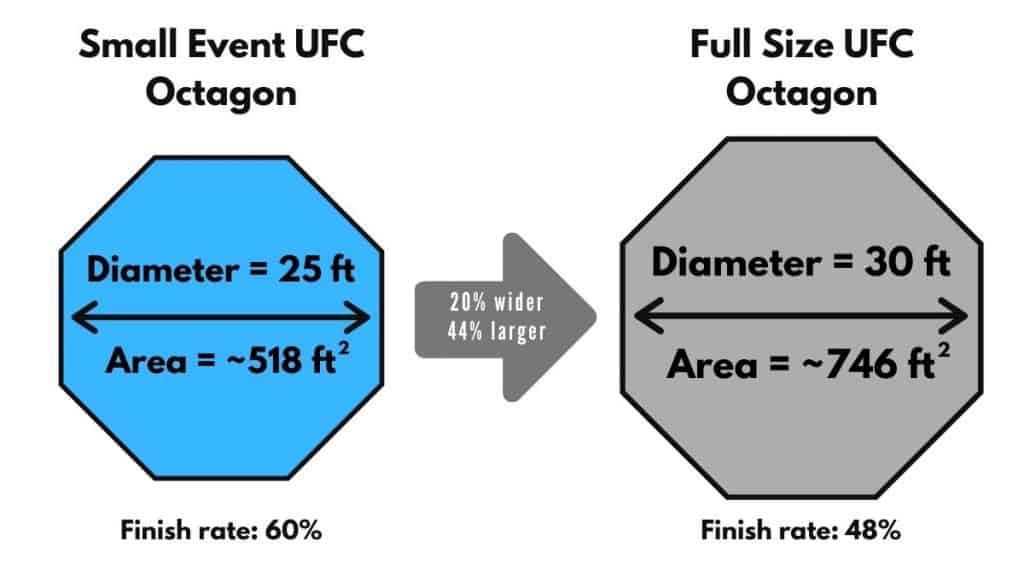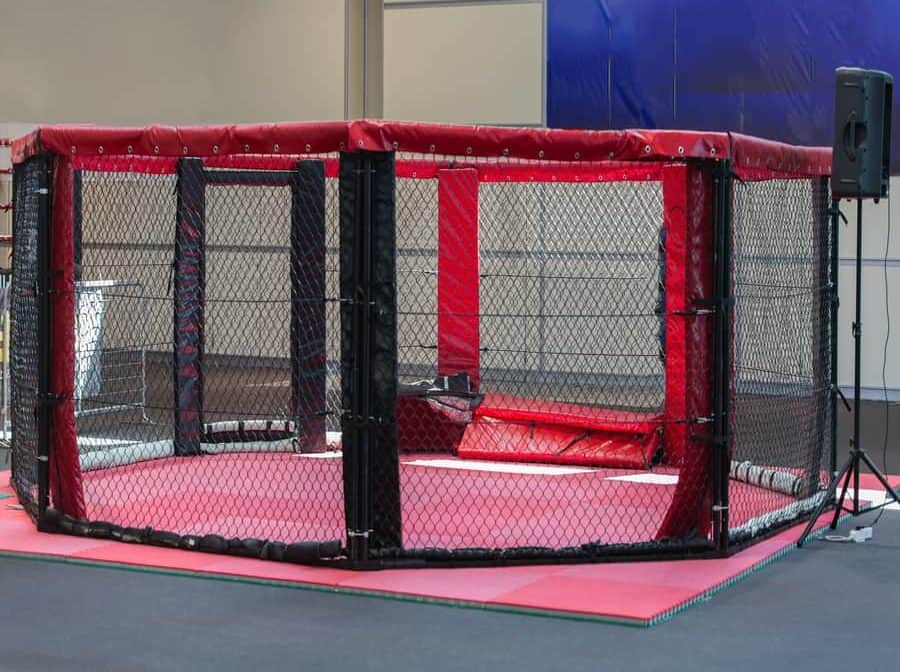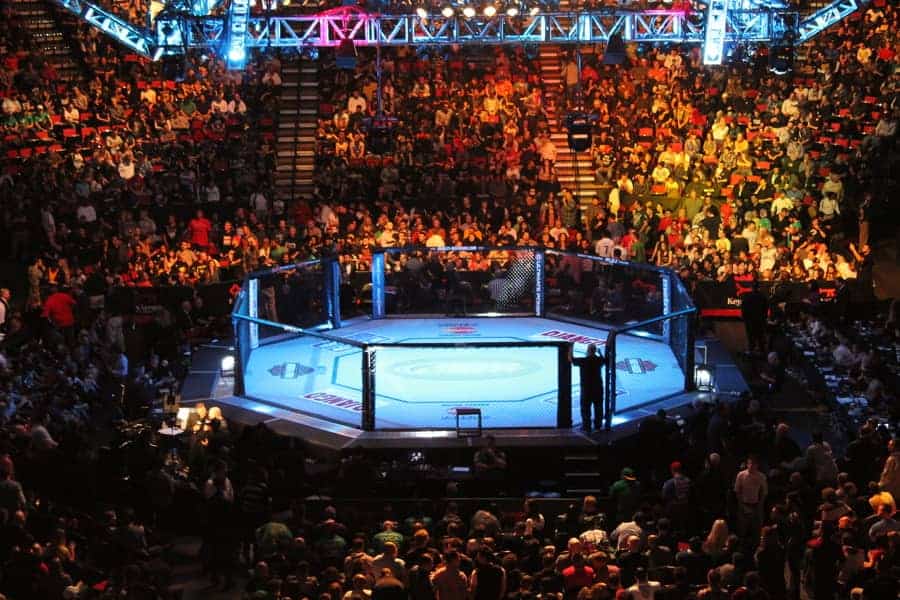From the first UFC event in 1993 to this day, every UFC fight was held inside an eight-sided polygon cage. That cage is known worldwide as the UFC Octagon. The UFC Octagon has a perfect shape to give fighters enough space to showcase their skills, and on the other hand, ensure the maximum safety for UFC fighters.
The standard UFC Octagon’s canvas (fighting space surrounded by the fence) has a diameter of 30 ft (9.1 m) with a 6-feet high fence. It is the one that is used most often and always for bigger events. For smaller events, UFC sometimes uses the Octagon with a diameter of 25 ft (7.62 m).
| Octagon type | Size (diameter) |
| Standard | 30 ft (9.1 m) |
| Smaller | 25 ft (7.62 m) |
The UFC’s eight-sided cage is made of state athletic commission-approved canvas with safety paddings and fences. A robust plastic-coated fence is here to prevent fighters from falling out of the Octagon (as there is a chance in traditional rings with ropes during boxing, kickboxing or Muay Thai fights).
Alongside the prevention of injuries, the unusual shape of the UFC’s Octagon also ensures that there is no usage of so-called “cutting off the rings” techniques that boxers and kickboxers like to use.
UFC Octagon Size
Let’s take a closer look at the size and dimensions of a standard UFC Octagon:
- the whole UFC Octagon (the part surrounded by the fence and the part outside the fence) has a diameter of 38 ft (11.5 m)
- interior of the Octagon (fighting space, surrounded by the fence), as already mentioned has a diameter of 30 ft (9.1 m)
- area size of the fighting space is around 746 square ft
- walkway; space, where Octagon girls walk around between the rounds showing the round number, is 4 ft wide and 4 ft high (1.2 m)
- the UFC Octagon also has two entrance gates, each on the opposite side of the Octagon. Each gate is 3 ft wide (0.9 m) and 5 ft high (1.5 m)
- height from the ground to the canvas of the Octagon is 4 ft (1.2 m)
- height from the canvas to the top of the fence is 5 ft, 9 inches (1.8 m)
- the UFC Octagon’s canvas is textured and hand-painted with logos from different sponsors. It is used only once for each event

The UFC Octagon is very specific because of its fence. In boxing, kickboxing, and Muay Thai events, there are ropes that can sometimes help the fighters (like rope-a-dope technique in boxing; technique commonly associated with Muhammad Ali in his 1974 Rumble in the Jungle match against world heavyweight champion George Foreman).
On the other hand, usage of the fence inside the Octagon can be translated to the creative attacking movements; or when defending from the grappling game on the ground (worth noticing is that grabbing of the fence isn’t allowed).
One of the best examples of the smart usage of the fence is when Anthony Pettis used it against Ben Henderson to perform a devastating flying kick off the cage.
The UFC Octagon, as we now know it, wasn’t always supposed to look like it looks now. When it all started back in 1993, there were ideas like the one that Octagon should be surrounded by a tank filled with water and sharks. As crazy as it sounds, that is how the story of the UFC’s Octagon history goes.
History of the UFC Octagon
The history of enclosed fighting spaces goes all the way back to Ancient Greece and sport known as pankration, which many consider as an ancient version of today’s modern MMA. Back in the day, there were no rules. Almost everything was allowed (except biting, gouging, and attacking the genitals).
Also, there were no cages or rings or any type of physical boundaries that fighters were enclosed by. There was only a line of dirt that marked the edge of the fighting space.
All the way through ancient times, e.g., in Rome, where slaves fought “inside” circles marked with a line on the ground, there were no rings or cages. In 1838, with London Prize Ring Rules, the boxing ring was introduced.
Boxing rings became usual for fighting events like boxing, kickboxing, Muay Thai, but the ropes of the rings were something that wasn’t exactly in the minds of the Octagon creators.
People think that Royce Gracie is the man who started it all (the Gracie family and Brazilian jiu-jitsu representative at the first UFC event). But, when it comes to the idea of Octagon, there are two people responsible for its creation – writer and director John Milius and Gracie’s family member, Rorion Gracie.
When Rorion Gracie came to the United States in 1969, he had a plan to introduce jiu-jitsu to the American public. He started by setting up jiu-jitsu classes in his garage but soon found out that wasn’t the right way to introduce jiu-jitsu to the whole world. He realized that TV was the way to do so.
During Rorion’s teaching of jiu-jitsu in his garage, one of his students was John Milius, a TV and movie writer and director. Rorion had an idea that he could promote jiu-jitsu through the fighting tournament composed of fighters with different fighting backgrounds.
The goal was to show the world that to perform jiu-jitsu effectively, size and strength didn’t matter. He approached John with his mission of making jiu-jitsu popular with the American public.
The TV guys loved the idea. It was unbelievably crazy, but they loved it. I used to teach John Milius and we started wondering how we could create a ring where the fighters couldn’t escape. I’ve seen a lot of fighters escape through the ropes when they’re getting beat. We came up with the idea to build a tank full of sharks or alligators around the ring, or maybe an electric fence. We considered everything, but in the end, we came up with the idea of an octagon.
Rorion Gracie

Does UFC Use Different Size Octagons?
As already mentioned, not all of the UFC Octagons are the same. In most cases, UFC uses their usual Octagon of a diameter of 30 ft (9.1 m). Sometimes, during the smaller events, they use an Octagon of a diameter of 30 ft (9.1 m). Although one can say that the size of the cage doesn’t matter, the stats gathered are showing that it isn’t exactly true.
| Octagon type | Diameter | Finish rate | Fight length |
|---|---|---|---|
| Standard | 30 ft (9.1 m) | 48 % | 651 seconds |
| Small Event | 25 ft (7.62 m) | 60 % | 593 seconds |
With the help of the data (courtesy to @fightnomics) of all UFC fights from December 15, 2012, through October 4, 2013, we can see a significant difference in fight outcomes. Of all fights held inside the standard UFC Octagon (diameter of 30 ft), 48 % of them ended in a finish, and the average fight lasted for 651 seconds. Fights held inside the smaller UFC Octagon (diameter of 25 ft) had a 60 % finish rate and lasted for 593 seconds on average.
When you give it a thought, there is a good explanation for why smaller Octagon yields more finishes. As the surface of the fighting area is smaller, there is less space for fighters to move around, and the time spend close to each other is bigger than when there is more space to move around.
For comparison, the Bellator cage is 36 ft (10.97 m) in diameter with 1018 square ft of fight area. On the other hand, the WEC cage was 25 ft (7.62 m) in diameter with just 482 square ft of fight area. The reason for WEC events being known to have had the most action is exactly because of the size of the cage. There isn’t much space to move around. The only way is forward to the opponent.
The next video of Jose Aldo punching Frankie Edgar is the perfect example:
When it comes to the fighters picking over the size of the UFC Octagon, the thoughts vary. Worth noticing is that the problem, according to some of the fighters, is that UFC doesn’t always give them the information on which Octagon they are fighting in.
“I noticed right when I stepped in,” says Rothwell, who won against Alistair Overeem with a first-round TKO finish at “UFC Fight Night: Jacare vs. Mousasi.” “I didn’t know it was that (the cage) was smaller. They told me after.”
“I don’t like fighting in that small cage,” Matt Mitrione says. “I’d rather fight in a field than a phone booth. We’re big bodies. You take two steps, and you’re fighting in the middle of it. For me, mobility’s a big part of my game – that and being athletic. For me, it feels like every time I make a movement, I’m a foot and a half from one side of the cage or the other, so it’s more difficult.”
Statistician Reed Kuhn made an analysis for his blog @fightnomics where he found out that fighters throw around 20 percent more strikes in the smaller cage than in the larger cage.

